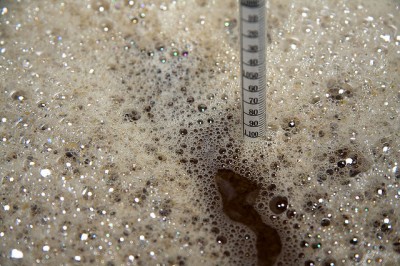Technically, a hydrometer isn’t required for home brewing, but it can certainly help your next batch of home brewed beer turn out a lot better.
A hydrometer kind of looks like something a mad scientist would use, it sort of looks like a thermometer that floats in your soon to be beer. It works by measuring the density of the liquid, the higher that it floats the more dense your wort.
Why would you want to know how dense your wort is? It’s because a dense wort, full of sugars will have a higher hydrometer reading. A wort that’s had it’s sugars transferred into alcohol, will have a lower reading. Get where I am going? Good!
When you’re brewing, you’ll want to measure the gravity of your wort before you pitch the yeast into it. That’s called the OG (or Original Gravity not to be confused with Original Gangster) and you’ll want to make sure your OG is on par with your recipe before you go throwing your yeast into it.
You measure it again after your yeast have finished fermenting. Don’t do it every day while your beer is fermenting, wait until the bubbles in your airlock have stopped for a 24-72 hours. Being patient is good, because the more your disturb your wort to take a measurement, the more that you could be contaminating it.
Taking a hydrometer reading seems simple, you just spot the point where the hydrometer sinks into your wort and record the number. However, with a lot of lines and numbers, it can be a little difficult at first. My best advice, is to look at it level with the wort and after a few batches, you’ll be taking wort measurements like a pro.
There is one other thing that you should know about a hydrometer, it’s set for 59 degrees Fahrenheit. That means that you have to make an adjustment based on what the actual temperature is of your wort. One of my favorite authors, John Palmer has a chart to help us make the temperature adjustment on the online version of his book How To Brew.
Using a Hydrometer kind of makes me feel like a mad scientist at times, it can seem pretty complicated but after a few times you’ll have it down to a science.
—
Photo by Another Pint Please….
